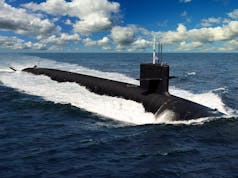Raytheon Missile Systems was awarded a $199.6 million firm-fixed-price contract for MK 15 Phalanx Close-In Weapon System (CIWS) upgrades and conversions, system overhauls, and associated hardware.
The deal will see the company overhaul Phalanx systems for the United States, United Kingdom and Saudi Arabia.
According to the contract notice:
“Work is expected to be completed by October 2023. This contract combines purchases for the U.S. government (85%); Kingdom of Saudi Arabia (8%); and the United Kingdom (7%) under the Foreign Military Sales (FMS) program.
Fiscal 2019 operations and maintenance (Navy); 2019 other procurement (Army); 2019 shipbuilding and conversion (Navy); FMS Kingdom of Saudi Arabia; FMS United Kingdom; and 2019 weapons procurement (Navy) funding in the amount of $199.6 million will be obligated at time of award. Funds in the amount of $60 million will expire at the end of the current fiscal year.
This contract was not competitively procured in accordance with 10 U.S. Code 2304 (c) (1). Raytheon is the only source that can provide the MK 15 CIWS to fulfill Navy, Army, Coast Guard, and FMS requirements without unacceptable delays and substantial duplication of costs that cannot be recovered through competition. The Naval Sea Systems Command, Washington, District of Columbia, is the contracting activity (N00024-19-C-5406).”
The system is a fast-reaction terminal defense against low- and high-flying, high-speed maneuvering anti-ship missile threats. This contract includes options which, if exercised, would bring the cumulative value of this contract to $367.2 million.













I wonder what the upgrades are.
The RN did buy some upgrade kits for Phalanx to take the 1A and 1B Baseline 1 to the 1B Baseline 2. The Baseline 2 has an updated Radar and optical systems.
The net effect is that ir is better against stealth targets and targets very close to the water – including boats.
Little is out there about the upgrade but it probably involved an ESPA radar.
The upgrade may be something to do with Baseline 2. I have not seen anything about a further Phalanx upgrade.
Rob N
I wonder if our Phalanx are ‘fitted for but not with’ bullets?
Can’t find out how to use emojis on this site so instead TS-hahahahahahaha-best of the day Squire!
Why thank you sir!
At my age my Phallus is certainly ‘fitted for but not with’ bullets!
They should be upgraded to SEARAM
Disagree colin. Phalanx as a gun sysrem is more adaptable than searaam. I would prefer more weaponry on all the RN and RFA vessels but the answer is to add layers of defence and have more options.
I’m not expert, I think Searam would work better at distance, but for close range I would rather rely on several hundred lead projectiles taking taking out an incoming missile than 2 or 3 complex missiles.
The SeaRam has at least three times the effective range of the 20mm gun. However, the missiles are rather small so don’t carry a large warhead. I suspect on larger anti-ship missiles it may take a couple of missiles to knock out.
The Phalanx at one point used depleted uranium rounds, but this has subsequently been swapped for tungsten. The thoughts are to put a blanket of rounds in the path of the missile to take out its seeker and with enough penetrative power to ignite the warhead and/or fuel. The weapon works in practice, but has yet to be used in a real scenario.
The upgrade to block 1B replaces the barrel with a longer calibre and adds the capability to be used against seaborne targets like small boats. The block 1b plus upgrades the radar. Unfortunately the contract doesn’t state what upgrades will be.
I believe the RN tried SeaRam a few years ago and was not impressed
I tend to agree, the Phalanx is a good final layer and with developments coming into the frame for longer range including Sea Ceptor and the promising new Martlet adaptation (and potentially others) I think they would be a better and more flexible bet filling in the area short of the Sea Viper of the T45s long range defence giving all the vessels extra potential freedom and flexibility depending on risk and needs. They would also give a good weapon flexibility adaptable to various platforms, ships and combinations too that can additionally be upgraded, re assigned and expanded as experience and costs allow. And a decent boost to British industry too.
The main problem with systems like this is they never seem to be turned on like in the case of the USN Perry class frigate that was hit with 2 Exocet missiles and the Israeli ship that was hit by a surface to surface missile.
Not turned on or reported as turned off to cover that the system failed. A system that is meant to be able to identify threats Vs passing ships and do friend/foe identification, it seems odd that they keep turning it off in high risk areas. Only way we will ever know for sure, if is there is a war, which hopefully there won’t be.
As in the case of the USS Stark the system was turned off by all the accounts of the incident I’ve read. At least back then when the system was relatively new captains were reluctant to put the system on auto fearing that it would engage something it wasn’t supposed to like a civilian aircraft or ship.
A think the system does not have an IFF instead it evaluates targets on a threat basis. So in automatic you would have to trust the AI.
The modern reality is that humans are slow and having them in the system might appear a good idea but in reality wen you only have seconds to react it is becoming unrealistic. With hypersonics there is no time for a debate that is why automatic systems should be used or ships will be lost.
It might not be good for the captain’s ego but AI must be allowed to act.
Rob N
Hence the reason why the US is spending so much money on shipborne lasers.
Some years ago, Oerlikon had a prototype upgrade for Phalanx mounts by swapping to their 25mm KBD rotary cannon. That would let you engage incoming missiles at greater range than the current 20mm. Sadly, it was not adopted. No point in one user adopting it, you would need all (or nearly all) Phalanx users to agree.